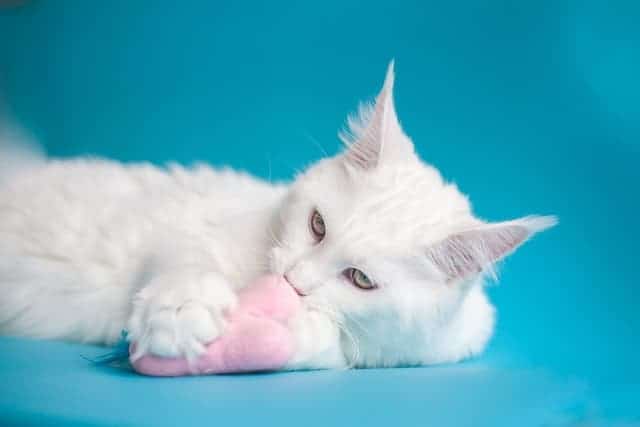
Cats are reproductively mature at 6 months and can have 3 heats a year, being able to give birth to 6 kittens in each pregnancy.
In a year you can have 18 kittens and the truth is that many of them will be born on the street and will face a very complicated life, full of dangers, accidents and many of them die within a few months of being born and those who arrive to adults, they survive thanks to the help of protectors.
Making the decision to sterilize your cat is one of the most important decisions you will make in your pet’s life. Learn why it is so important to sterilize a cat.
What is the sterilization of a cat
Sterilization is a small intervention that is done on the animal so that it cannot reproduce .
In the case of males it is called castration (amputation of the testicles). In the case of females it is commonly called “emptying“, that is, the removal of the ovaries and uterus.
Sterilization vs Spaying in cats : what is the difference
Spaying cats is called oophorectomy and involves the removal of the cat’s ovaries.
That said, although it may seem somewhat traumatic, they are common operations , which are performed more and more frequently, with a very fast recovery and which in many cases, has positive effects on the quality of life of cats, especially because we greatly limit measure, possible diseases that could develop in the future.
In addition to avoiding behaviors that can be annoying, derived from their zeal and of course, to avoid that if a cat has access to the outside, she becomes pregnant.
That is why we recommend that if you are thinking of sterilizing a cat , you take it into account and consult with your trusted veterinarian. Prevention is often better. Don’t you think
Reasons to sterilize a cat
As a responsible owner of your cat, you would have to neuter or sterilize it. This will put an end to your feline pet’s sexual instincts, and the customs associated with them. A female has to undergo a slight surgical intervention (spaying or emptying), and a male has to be neutered.
Advantages of sterilizing a cat
- The castrated female will stop having heat cycles, meowing and screaming insistently in search of a male.
- You will prevent your cat in heat from marking your home with feces, urine or scratches.
- Neighborhood cats will stop coming to your door spraying urine on it and trying to mate with your female.
- You will prevent the cat from developing ovarian cysts or uterine cancer if she is not allowed to have offspring in the future.
- It greatly reduces the risk of breast cancer.
- Pyometry or womb infection is prevented.
- You avoid possible unwanted pregnancies and the responsibility of having to find a new home for a litter that can be up to 10 kittens.
- You will feel more comfortable and relaxed being indoors as you will be less stressed.
- Sexually transmitted diseases are avoided.
Advantages of neutering a cat
- Your neutered male will stop trying to escape from home at any opportunity and will not get into fights when it encounters other males.
- The male is prevented from urinating all over the house by marking the territory.
- You will feel more satisfied and at ease staying at home.
- It reduces the risk of prostate cancer and genitourinary infections.
- It seems to be true that neutered cats are more affectionate towards people.
- You prevent her from getting any stray cat pregnant and having kittens with a really hard life .
- You prevent your cat from spending long periods “roaming” outside the home.
Neutering avoids cat health problems
One of the most important reasons when deciding to sterilize a cat is because we are going to avoid health problems, especially the dreaded breast or uterine tumors, or cervical cancer that are usually common, in those cats not sterilized and that with sterilization is considerably reduced. Therefore, even if your cat does not have access to the outside, this practice can improve her quality of life.
Neutering may solve cat behavioral problems
When a cat who has had several jealousies without mating with other cats, she can develop behavioral problems , with symptoms such as poor appetite, vomiting, anorexia nervosa or a low mood. It is also possible that he could try to get away at some point . By sterilizing the cat, these problems disappear.
A better coexistence at home
A cat can have up to 4 heats in a single year. During this period, they usually meow continuously. Sterilization in this case will also eliminate these behaviors that can make coexistence in the domestic environment difficult in some cases.
Is it true that sterilized cats get fat?
If a neutered cat’s diet is regulated, and given enough exercise and opportunities to play, there is no reason for it to gain weight. If you notice that your cat is getting fat, reduce its daily food ration.
Just remember that you have to provide a balanced diet. The quality of the diet remains the same, only the quantity is reduced.
When to sterilize your cat?
Your vet will advise you on the appropriate age to neuter your cat. Although any age is good to do it, it is usually recommended not to do it before 6 months of age . But we insist, your vet will be the one who can best decide.
In general , it is recommended when you have had the first heat, this comes to be from 7-8 months . This is what is accepted as a rule, but the truth is that each some veterinarians opt for an earlier sterilization , even before reaching sexual maturity, this would be in the 5 or 6 month of life.
There are many theories in favor of one or the other and when the time comes, it is the veterinarian who advises you on the best time to do it, as it will depend on more factors to evaluate.
In the case of adult cats, which have been adopted , any age is good for their sterilization and improvement of their quality of life, in a domestic environment.
It must be borne in mind that if a cat has been a mother, it is very important, first of all, to avoid any contact with males during this period, to prevent her from becoming pregnant again.
The sterilization should be done when the kittens are 8 weeks old , when weaning occurs . From that moment on, the cat can be sterilized without problems, but check with your vet first.
Normally you will have to bring your cat for the intervention early in the morning. Generally, a male can return home that same afternoon, but since the surgical process that a female has to undergo is more complex, it is normal for her to spend the night in the hospital and only be able to return home the next day.
This can vary, depending on the cat and the vet. After the intervention, your veterinarian will tell you what care your cat needs.
Sterilization of a cat : what does it consist of?
As we have described before, sterilization is the procedure by which the sex glands of cats are removed, and heat disappears in cats.
In the sterilization of cats, there are two most common methods. In the case of performing an ovariectomy , the ovaries are removed and in ovariohysterectomy , the ovaries and uterus are removed.
In both cases, it can be done from behind, in the kidney area, or through the abdomen and a small cut will be necessary , as well as shaving the surgery area.
Are there other options?
They do exist but they are less recommended, as they can have adverse side effects and are not effective methods.
Spaying without castration in cats
In this case, what is done is in the case of females, it consists of a tubal ligation , that is, the reproductive ducts are blocked , but in these cases, the effects of heat and marking will persist, because the organs sexual are intact.
Most veterinarians advise against this method, because it does not prevent most of the related problems mentioned above.
Chemical sterilization in cats:
It is an uncommon method and it is carried out, regularly supplying drugs that inhibit sex hormones and thus prevent pregnancy , but not heat and all the problems derived from health and behavior.
It is even possible that there are negative side effects for the cat, which negatively affect her health.
What care should you take before and after sterilization of cat?
In the postoperative period of sterilization in cats , follow the advice of your veterinarian, who will surely ask you to take him on an empty stomach on solid food from the night of the previous day and on liquids from the morning of sterilization.
Once completed, discharge is quick and that same day it is very possible that we can return home. Try to rest him in a quiet place, until the effects of the anesthesia wears off completely.
In both males and females, no special measures should be taken, except to monitor the wound from the operation, which is usually very small. Avoid licking a lot and check that it heals properly. If you have any questions or problems, go to your vet .
Price of sterilizing a cat?

If you have thought about how much it costs to sterilize a cat , the price varies between cities and countries. It is generally a bit more expensive for females than males and can range from $200 to $400 .
If your cat is adopted, you should know that many protectors work with specific veterinary clinics and the price is cheaper if you go through them (they are usually already sterilized).
The important thing is that you always do it in a veterinary clinic with adequate guarantees and means to carry out these sterilizations .
We also want to tell you that this article is merely informative and we will always recommend that you go to your veterinarian, if you have any questions.






